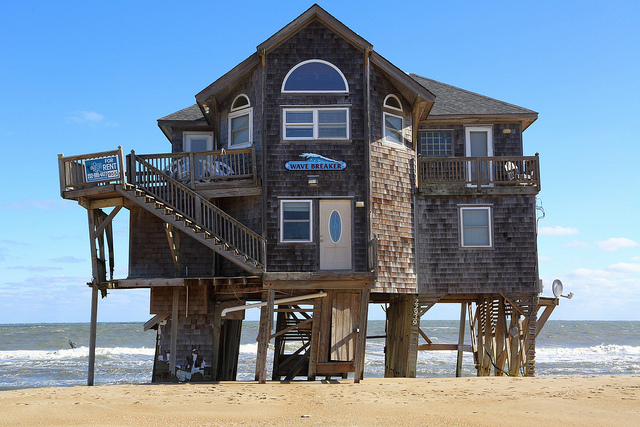Archive for November, 2016
Sometimes things need to get worse before they can get better.
 All the scary words are grounded in change. Innovation, by definition, is about change. When something is innovative it’s novel, useful and successful. Novel is another word for different and different means change. That’s why innovation is scary. And that’s why radical innovation is scarier.
All the scary words are grounded in change. Innovation, by definition, is about change. When something is innovative it’s novel, useful and successful. Novel is another word for different and different means change. That’s why innovation is scary. And that’s why radical innovation is scarier.
Continuous improvement, where everything old is buffed and polished into something new, is about change. When people have followed the same process for fifteen years and then it’s improved, people get scared. In their minds improved isn’t improved, improved is different. And different means change. Continuous improvement is especially scary because it makes processes more productive and frees up people to do other things, unless, of course, there are no other things to do. And when that happens their jobs go away. Every continuous improvement expert knows when the first person loses their job due to process improvement the program is dead in the saddle, yet it happens. And that’s scary on a number of fronts.
And then there’s disruption. While there’s disagreement on what it actually is, there is vicious agreement that after a disruption the campus will be unrecognizable. And unrecognizable things are unrecognizable because they are different from previous experience. And different means change. With mortal innovation there are some limits, but with disruption everything is fair game. With disruption everything can change, including the venerable, yet decrepit, business model. With self-disruption, the very thing responsible for success is made to go away by the people that that built it. And that’s scary. And when a company is disrupted from the outside it can die. And, thankfully, that’s scary.
But change isn’t scary. Thinking about change is scary.
There’s one condition where change is guaranteed – when the pain of the current situation is stronger than the fear of changing it. One source of pain could be from a realization the ship will run aground if a new course isn’t taken. When pain of the immanent shipwreck (caused by fear) overpowers the fear of uncharted waters, the captain readily pulls hard to starboard. And when the crew realizes it’s sink or swim, they swim.
Change doesn’t happen before it’s time. And before things get bad enough, it’s not time.
When the cruise ship is chugging along in fair seas, change won’t happen. Right before the fuel runs out and the generators quit, it’s all you can eat and margaritas for everyone. And right after, when the air conditioning kicks out and the ice cream melts, it’s bedlam. But bedlam is not the best way to go. No sense waiting until the fuel’s gone to make change. Maybe someone should keep an eye the fuel gauge and let the captain know when there’s only a quarter tank. That way there’s some time to point the ship toward the closest port.
There’s no reason to wait for a mutiny to turn the ship, but sometimes an almost mutiny is just the thing.
As a captain, it’s difficult to let things get worse so they can get better. But if there’s insufficient emotional energy to power change, things must get worse. The best captains run close to the reef and scrape the hull. The buffet tables shimmy, the smoked salmon fouls the deck and the liquor bottles rattle. And when done well, there’s a deep groan from the bowels of the ship that makes it clear this is no drill. And if there’s a loud call for all hands on deck and a cry for bilge pumps at the ready, all the better.
To pull hard in a new direction, sometimes the crew needs help to see things as they are, not as they were.
Image credit – Francis Bijl
Connection Before Numbers
 Compound annual growth, profit margin, Key Business Indicators, capability indices, defects per million opportunity, confidence intervals, statistical significance, regression coefficients, temperature, pressure, force, stress, velocity, volume, inches, meters, decibels. The numbers are supposed to tell the story. But they don’t.
Compound annual growth, profit margin, Key Business Indicators, capability indices, defects per million opportunity, confidence intervals, statistical significance, regression coefficients, temperature, pressure, force, stress, velocity, volume, inches, meters, decibels. The numbers are supposed to tell the story. But they don’t.
There’s never enough data to see the whole picture. But, even when the discussion is limited to topics covered by the data, people don’t see things the same way. And even if the numbers were 100% complete, there would be no common interpretation. And if there was a common interpretation there’d be a range of diverging opinions on how to move forward. Even with perfect numbers, there is divergence among people.
Numbers are numb. They don’t have meaning until we attach it. And, as entities that attach meaning, we think do it rationally. But we use past history and fear to assign meaning. We are not rational, we’re emotional. Even the most rigorous scientist has an obsessive nature, infatuation and deep fascination. Even when swimming in a sea of data, we’re emotional, and, therefor, irrational.
Excitement, happiness, joy, anxiety, sadness, fear, collaboration, cooperation, competition, respect, disrespect, kindness, love. We live and work in a collection of people systems where emotion carries the day. Emotion and irrationality are not bad, it’s the way it is. We’re human. And, I’m thankful for it.
But with emotion and irrationality comes connection as part of the matched set. If you want one, you have to buy all three. And I want connection. Connection brings out the best in people – their passion, energy and love. When magical things happen at work, connection is responsible. And when magic happens at home, it’s connection.
I’m thankful I have strong connections.
Image credit – Irudayam
Where there’s fun there is no fear.
 For those who lead projects and people, failure is always lurking in the background. And gone unchecked, it can hobble. Despite best efforts to put a shine on it, there’s still a strong negative element to failure. No two ways about it, failure is mapped with inadequacy and error. Failure is seen as the natural consequence of making a big mistake. And there’s a finality to failure. Sometimes it’s the end of a project and sometimes it’s the end of a career. Failure severely limits personal growth and new behavior. But at least failure is visible to the naked eye. There’s no denying a good train wreck.
For those who lead projects and people, failure is always lurking in the background. And gone unchecked, it can hobble. Despite best efforts to put a shine on it, there’s still a strong negative element to failure. No two ways about it, failure is mapped with inadequacy and error. Failure is seen as the natural consequence of making a big mistake. And there’s a finality to failure. Sometimes it’s the end of a project and sometimes it’s the end of a career. Failure severely limits personal growth and new behavior. But at least failure is visible to the naked eye. There’s no denying a good train wreck.
A fumble is not failure. When something gets dropped or when a task doesn’t get done, that’s a fumble. A fumble is not catastrophic and sometimes not even noteworthy. A fumble is mapped with a careless mistake that normally doesn’t happen. No real cause. It just happens. But it can be a leading indicator of bigger and badder things to come, and if you’re not looking closely, the fumble can go unnoticed. And the causes and conditions behind the fumble are usually unclear or unknown. Where failure is dangerous because everyone knows when it happens, fumbles are dangerous because they can go unnoticed.
Floundering is not fumbling. With floundering, nothing really happens. No real setbacks, no real progress, no real energy. A project that flounders is a project that never reaches the finish line and never makes it to the cemetery. To recognize floundering takes a lot of experience and good judgment because it doesn’t look like much. But that’s the point – not much is happening. No wind in the sails and no storm on the horizon. And to call it by name takes courage because there are no signs of danger. Yet it’s dangerous for that very reason. Floundering can consume more resources than failure.
Fear is the fundamental behind failing, fumbling and floundering. But unlike failure, no one talks about fear. Talking about fear is too scary. And like fumbling and floundering, fear is invisible, especially if you’re not looking. Like diabetes, fear is a silent killer. And where diabetes touches many, fear gets us all. Fear is invisible, powerful and prolific. It’s a tall order to battle the invisible.
But where there’s fun there can be no fear. More precisely, there can be no negative consequence of fear. When there’s fun, everyone races around like their hair is on fire. Not on fire in the burn unit way, but on fire in the energy to burn way. When there’s fun people help each other for no reason. They share, they communicate and they take risks. When there’s fun no one asks for permission and the work gets done. When there’s fun everyone goes home on time and their spouses are happy. Fun is easy to see, but it’s not often seen because it’s rare.
If there’s one thing that can go toe-to-toe with fear, it’s fun. It’s that powerful. Fun is so powerful it can turn failure into learning. But if it’s so powerful, why don’t we teach people to have fun? Why don’t we create the causes and conditions so fun erupts?
I don’t know why we don’t promote fun. But, I do know fun is productive and fun is good for business. But more important than that, fun is a lot of fun.
Image credit – JoshShculz
Good teachers don’t always look like teachers.
 When you’re laying in your camping tent dead tired and wanting for sleep the last thing you want is a rouge mosquito that dive-bombs you continuously throughout the night. With each sortie, it pushes on your expectations of how things should be. This little creature, so small and so powerless, becomes powerful enough to ruin a good night’s sleep. But, really, the mosquito itself doesn’t become powerful at all. You give the mosquito its power, power generated by a mismatch between what you want (sleep) and what is (a little bug flying around). This mismatch causes you assign intent to the mosquito which leads you to tell yourself a story of an insect on a singular mission to upset you. Truth is, the mosquito is on a mission, a mission to teach you the self destructive power of making little things into big things. The mosquito is your teacher.
When you’re laying in your camping tent dead tired and wanting for sleep the last thing you want is a rouge mosquito that dive-bombs you continuously throughout the night. With each sortie, it pushes on your expectations of how things should be. This little creature, so small and so powerless, becomes powerful enough to ruin a good night’s sleep. But, really, the mosquito itself doesn’t become powerful at all. You give the mosquito its power, power generated by a mismatch between what you want (sleep) and what is (a little bug flying around). This mismatch causes you assign intent to the mosquito which leads you to tell yourself a story of an insect on a singular mission to upset you. Truth is, the mosquito is on a mission, a mission to teach you the self destructive power of making little things into big things. The mosquito is your teacher.
When it’s time to learn, the best teachers show up as if on command. When things have been going well for a while and you’re getting a little stale, your supportive boss contracts yellow fever to make room for your teacher. Your teacher, in the form of your new boss, shows up the first day with all the wrong answers and the strong desire to standardize on them. Your teacher challenges you to look inside for the motivation to elevate your game and demands you bring creativity and clarity of unrivaled proportions. Your terrible boss doesn’t know enough to ask for the right things so you end up solving oblique problems that on the surface seem meaningless. But, because you had to solve a new problem in a new way you come up with a variant that ends up transforming your mainstream business. Your terrible boss is your teacher.
Due to an economic slowdown, the multinational you work for eliminates your division and you lose your job. As you search for a job and collect unemployment you have a little time so you start a crazy side project. It doesn’t matter if it works because it’s just a diversion from your miserable situation, so you try it. And, as it turns out the impossible is actually possible and you start a whole new business on your prototype. Your miserable situation is your teacher.
Instead of getting angry at your new situation and feeling terrible about yourself, embrace the newness and let it be your teacher. Be humble, watch it unfold and see where it takes you. Use it to see yourself differently. Use it to challenge your assumptions.
And, most importantly, as you take the wild ride, hold on to your hearts best intention.
Image credit – Andreas.
Business Models Are Finite
 Like it or not, everything changes. The rock solid brand will erode and the venerable business model will wither and die. Though you will add immense energy to hold on to what you built, natural forces of competitive evolution will come up with something makes your best work extinct.
Like it or not, everything changes. The rock solid brand will erode and the venerable business model will wither and die. Though you will add immense energy to hold on to what you built, natural forces of competitive evolution will come up with something makes your best work extinct.
We see it in our everyday lives. Houses need new roofs, cars needs new tires and our kids grow out of their best clothes. Sure we do everything we can to make things last, but we know that ultimately the roof will collapse and the tires will blow out. It doesn’t matter if we don’t want it to happen. It will happen without our consent. And we can see it coming. The roof loses some shingles, some tar paper shows through in spots and we know the leaks will follow. The leaks are not wanted, but they’re not a surprise. And it’s the same with tires. They start to rumble at highway speed, they get you stuck in snow that wasn’t a problem last year and the hydroplaning is inevitable. It’s not if it’s when. You rotate them, you keep them inflated and you know they will give it up. If you’re surprised it’s because you didn’t pay attention.
But in business we deny our business models have a natural life span and we deny what worked last year will not always work next year. And like with tires the signs of wear are obvious, but we dismiss the bumpy ride and the loss of traction in the market. And when the tar paper is clearly showing through the business model and someone points it out they are ignored or even ostracized for calling attention to the deep problem. And that’s the thing – it’s too deep to acknowledge, too deep to talk about. It’s too uncertain and therefore too frightening. The fear of a dwindling reality is stronger than the fear of doing something new so we put plywood over the windows and try to ride out the storm that will only get stronger.
Plywood is good when the radar says the hurricane will last for three hours. But plywood isn’t going to cut it when the fifth hurricane in a month picks up the house and blows it into the next county. The decision to evacuate the business model and abandon what worked is a tough one. It’s emotionally charged. There are pictures on the wall of four generation of CEOs and there are memories of successful production launches and an unnamable feeling of comfort in everything, including the bad cafeteria food you grew up on.
To ignore the natural forces of change is unskillful. It’s not good for the stock price but more importantly it’s not good for your personal wellbeing. It’s emotionally draining to bury the truth from yourself and it’s an immense waste of resources to continually prop up something that should be evacuated.
It’s not safer to bury your head in the sand. Call attention to the leaky roof and point out that people aren’t supposed to need to add air to leaky tires every other day. And when they dismiss you, don’t accept it. No one can dismiss you without your consent. Don’t give it to them.
Image credit – Don McCullough
 Mike Shipulski
Mike Shipulski